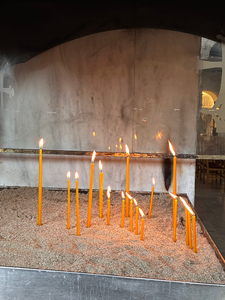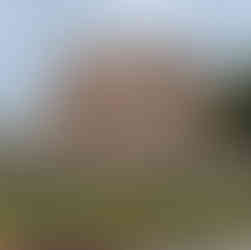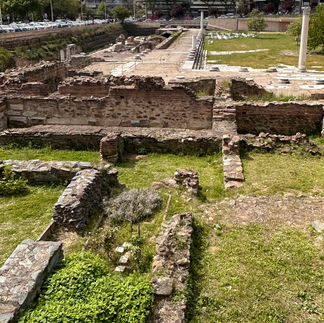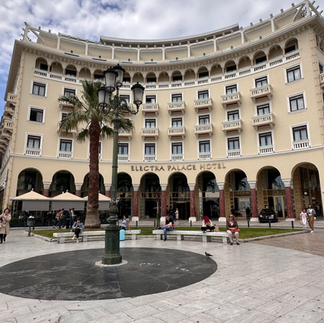Thessaloniki, Greece: Who knew? (we came to do laundry - and found UNESCO sites)
- debbiemanderson1
- May 17, 2023
- 6 min read

None of us had heard of Thessaloniki, Greece, four months ago. But in planning our most recent European adventure, it jumped out as a smaller city that might be a good place to recharge after the chaos of Istanbul and before we arrived in touristy Athens - and we were right.
After a short one and a half hour flight, we arrived at the Thessaloniki Airport Makedonia which was calm and quaint compared to the massive, world-class, Istanbul International. Again, we had a driver waiting as it was in the evening, and we wanted a quick and smooth transition to our accommodation, the Elisabeth Boutique Hotel, a new hotel about four blocks from the seafront. The hotel has a unique design and all the most modern technological features - and quirks that go with. The breakfast buffet had food for all tastes which is common in European cities as they cater to guests from all over the world with different food customs and preferences. Olives for breakfast, anyone?
Thessaloniki is a port city in northern Greece, the second largest city (after Athens) in the country. It sits on the northwest corner of the Aegean Sea and is important for being a connection route between the Mediterranean Sea and the Balkan countries. Unbeknownst to us four months ago, Thessaloniki is a popular tourist destination.

We found Thessaloniki, just as we thought, to be the perfect place to do laundry and relax for a few days mid-trip. The population of the greater area is about one million, but the central area with all the history and sites is small, about 318,000 population, and easy to navigate with the seafront being a guidepost. We walked everywhere. There is no metro, but one is in the works with the expected opening of the first line to be the end of December 2023. This is a ‘downtown’ map showing all the main sights in a concentrated area.
A laundromat is a good place to plan your next adventure:

As we began investigating Thessaloniki, it became clear that we should have read up on Greek history. Just a little bit of knowledge would make a trip to anywhere in Greece more meaningful. After all, being the birthplace of Western civilization is pretty significant.
The central area of Thessaloniki is divided roughly lengthwise into two main areas, the downtown along the seafront and the old town (Ano Poli) extending high up on the hillside. The downtown contains the major shopping street Tsimiski, side streets with small shops (many were textile shops with reams of colourful fabrics which we found interesting) and cafes, a university, the Ladidika area full of taverns and remarkably good restaurants, and the beautiful seafront walk. Ano Poli extends high up the hillside, characterized by the old city wall, fortress, historical artifacts, steep winding streets, and ‘suburbs’ where you will see a modern ‘townhouse’ butting up against a deteriorating stone structure.
Some steep streets and steps of Ano Poli:
Thessaloniki is known to be a centre of culture in Greece. In fact, it was named European Capital of Culture in 1997. It has 15 UNESCO World Heritage Sites and some 30 museums, along with arts and culture festivals. That’s a lot of UNESCO sites and museums for a city that size. Although we did not attend any museums, we saw almost all of the UNESCO sites without even trying because they are concentrated in such a small central area.
Here are some of the historic, and breathtaking, sites in Thessaloniki:
The Hagios Demetrios (Church of St. Demetrious), the current model dating to the year 629:
The Byzantine Baths dating to the 12th century:

The Church of Panagia Chalkeon dating to the 11th century:

The Hagia Sofia Church dating to the 7th century:
The Arch of Galerius dating to the 4th century:

The Rotunda of Galerius dating to the 4th century:
The ruins of the Palace of Galerius dating to the 3rd century, situated in the Navarinou Square:
The Vlatadon Monastery dating to the 14th century:
The preserved section of the Byzantine Wall, some four kms long, dating to the 3rd century and originally built to protect the old town:



The Trigonion Tower, a defensive tower and part of the walls:

The Heptapygiron Castle, looking down over the city from within the walls, dating to the third century, but used as a prison until 1989:
The two-levels church of Taxiarches dating to the 14th century, the current 'model' dating to 1953:

The Roman Forum or Ancient Agora of Thessaloniki, dating to the 2nd century:
In contrast to the ancient history, Thessaloniki is also known for it's modern seafront walk. The promenade was rebuilt in 2013 and has won international acclaim for it’s design. It takes you by the harbour, ferry station, fountains, cycling paths, cruise ship docks, parks, the famous White Tower, the Concert Hall, and the unique “The Umbrellas” statue that was built by a Greek architect in 1997 in honour of Thessaloniki being named Europe’s Capital of Culture.
One of the the most popular sites along the waterfront is the White Tower. It was previously part of the fortification of the city and later a notorious prison. Today, it is a museum:

The statue of Alexander the Great silhouetted:

The fun and interesting ‘The Umbrellas’ statue:

The photo ‘ops’ are endless . . . but we are definitely not the first to take this picture.

Thessaloniki has several traditional town squares that might not be as grand as those in some other cities but are historic and pleasant. The main square is Aristotelous Square, starting at the seafront and extending through the downtown to the Church of St. Demetrius (Hagia Demetrius):
The food in Thessaloniki was a joy. We ate our three suppers in the Ladidika area in large restaurants which we might normally shy away from due to high tourist traffic; but when your city is known as the gastronomic and culinary capital of Greece, ALL restaurants have to produce quality. Seafood and meat are popular here. I especially liked the diversity and creativity of the salads.
Speaking of pastry, Greece is big on phyllo pastry with fillings, but I turned 65 years old in Thessaloniki and devoured perhaps the best piece of baking I have ever had in our travels, maybe ever in my life, a strawberry cream tart with sugary crumble. Here’s a birthday celebration I will never forget, in Ano Poli, Thessaloniki, 10,000 kms from home:
And then free dessert and the birthday song from the Greek waiters:
Coffeehouses - old and new - are everywhere. One unique feature is the carry-away coffee bars, sometimes side by side, with no tables, just coffee and maybe a pastry ‘to go' or to stand and visit. Here’s just one of the hundreds of enticing coffee shops, this one with the same name and spelling as my travelling companion:
And maybe one more:

Besides having an abundance of UNESCO World heritage sites and the pleasant seafront walk, Thessaloniki has two traditional market places, Kapani and Modiano, in the centre of town. There seemed to be an abundance of seafood and fresh meat, and we were fascinated by the goats’ heads and entrails for sale. Apparently, entrails are stuffed and goats heads are cooked - I believe the heads are roasted and then the broth and meat are used for curries and soups. We did not try them.

Some of the more interesting meat and fish products:
Finally, Thessaloniki is simply a great city for walking and taking photos:
We spent three full days in Thessaloniki which was a perfect amount of time for us. Our purpose was to recharge ourselves, but after catching up on dirty laundry, we found much to see in an unhurried and relaxed manner. If you have time and a different agenda, there are several day trips that would be worth taking, the most popular probably being the Monasteries of Meteora, a group of six monasteries built high on million year old rock formations. (We’ve probably all seen this in travel advertisements for Greece.) You can imagine that with all the ancient history in Greece, there are several amazing archaeology sites to visit nearby.
Thessaloniki is well worth the visit, either for a recharge or for a more purposeful visit. It is a small and historic, but modern, city. It’s a place of ancient ruins and churches and textiles and scooters and coffee and street art and culture and tasty food and umbrellas. As the saying goes, “Who knew?”


















































































































































Comments